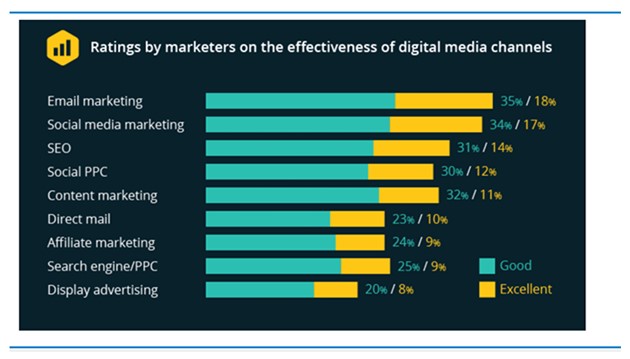A Guide to Affiliate Marketing
How Do You Start an Affiliate Marketing Business?
If anything, 2022 has left a lot of us wondering how to be more financially independent by starting our own side hustle or rather our own business – you know “be my own boss” kinda thing. Having spent a lot of time at home, a lot of us did just that and a lot of us turned to affiliate marketing.
Affiliate marketing is a great way to start your own business, or maybe a side hustle that you hope to turn into a full-time job.
This article will serve as a comprehensive guide to affiliate marketing, how to get started with affiliate marketing as well as how to grow your affiliate marketing business.
And to help you even more, I will share with you some tips that will help you take your affiliate marketing business to the next level, a level where you will be able to have an additional stream of income that will free you up to be more financially independent, which is after all the goal here at Sleepy Money.
While my website is all about how to make money work for you, I will start off by saying that starting your own affiliate marketing business will require time and hard work on your behalf. But do not let that discourage you.
 Unfortunately in this world, there is no big red button that you can push that will instantly result in you making millions of dollars. However, affiliate marketing is definitely one of the best ways to generate passive income, or nearly passive income online.
Unfortunately in this world, there is no big red button that you can push that will instantly result in you making millions of dollars. However, affiliate marketing is definitely one of the best ways to generate passive income, or nearly passive income online.
And, with this comprehensive guide to affiliate marketing, or rather this affiliate marketing bible, you will have everything you need to use affiliate marketing to grow your bank account, every day!

Affiliate Marketing Myth Buster
Affiliate marketing does not require you to have a specific trending or “super-specialized” industry. Affiliate marketing is a great way to monetize your online traffic and earn additional income. It’s a versatile stream of revenue that you can leverage no matter what your industry or niche.
What is Affiliate Marketing?
Since I’m going to be writing all about affiliate marketing, let me start with a quick definition of affiliate marketing.
Affiliate marketing means to promote and/or sell another company’s products or services for a commission.
Affiliate marketing is not a multi-level marketing scheme, affiliate marketing simply means using your own channels to promote and sell other people’s products. The concept is very simple, and this article will show you how to do it.
What you probably don’t realize is that almost any company or product that you can think of has an affiliate marketing program and will offer commission or money in return for affiliate marketing. All you need to do is ask!
How Much Money Can You Make
With Affiliate Marketing?
| Annual Salary | Monthly Pay | |
|---|---|---|
| Top Earners | $400,000 | $33,333 |
| 75th Percentile | $208,000 | $17,333 |
| Average | $154,700 | $12,891 |
| 25th Percentile | $60,000 | $5,000 |

How Does Affiliate Marketing Work?
Let’s discuss the basics of affiliate marketing, how does affiliate marketing work.
While affiliate marketing could be done offline, it would require you to physically send customers to a store, and it would be difficult to track what they buy, how much they spend, and your commission. Additionally, it would be even harder to track if they ever return to that store to purchase more products in the future.
So when I talk about building your own affiliate marketing business, I’m talking about creating an online business. So how does it work?
In affiliate marketing, a brand or seller who offers an affiliate marketing program (most of them do) will provide you with your own unique link that you can use to promote that seller’s products or services. This unique link allows you and the seller to see how much traffic you drive to the seller’s website or online store, as well as how many people buy, what products they buy, and how much they spend.
Yep, all that and more can be tracked by the use of a simple unique link! That’s the magic of cookies. When someone clicks on your affiliate link a cookie is stored in their browser. From that point on, the seller will always know that you send that customer to their website or online store and will be able to track all their transactions and give you credit for them. Because cookies don’t expire, even if the person you send to a website does not buy right away it will still record it if they do return and buy at a future date. It also records if they do buy, and then later return and buy more.
As an affiliate marketer, your job is to create traffic to a specific website, online store, or product page, by promoting your unique link provided by the seller.

Affiliate Marketing Tip
While success in affiliate marketing does not require you to choose a trending or “super-specialized” industry or niche, I can advise that you should choose to promote products and services that you yourself have tried, that you like, or that you believe will be beneficial for your customers.
The Four Main Pieces of Affiliate Marketing
There are four main pieces or “parts” to affiliate marketing:
- Sellers: these are products, brands, and people with online stores and websites that sell services or products.
- Affiliates: people who work to promote the seller’s services or products by driving traffic to their website or online store. You.
- Networks: when affiliate programs get very big a brand may form a network that will help manage all their affiliate marketers by providing helpful information, marketing tools, promotional tips, as well as guidelines, handle commissions, and so on.
- Consumers: these are your customers that you promote to and send to the seller’s website or online store. The end users of the product.
Let’s take a closer look at each part:
Sellers
The seller is the brand or the creator of the product. Often it can be a start-up, but more often it will be a well-established business that sells products or services that thousands or millions of people use every day.
They’re the ones who pay affiliate commissions for sales. Sellers can be individuals or companies—anyone willing and able to pay affiliates for sales.
As I mentioned earlier, you will be surprised at how many brands offer an affiliate marketing program. All you need to do is ask. For example, even Amazon has an affiliate marketing program!
Affiliates
Affiliate marketers can be either individuals (you) or businesses. Often, affiliate marketers are people who create online content that already gets a steady flow of traffic. By promoting a product or service to their existing audiences, using an affiliate link, they drive traffic to a seller’s online store through social media, blogs, videos, and various other online channels. However, if you are not an influencer or content creator you can still drive traffic to someone’s website or online store through paid online advertising.
Consumers
Consumers are the customers that you send to the seller’s website or online store. If you are a creator or influencer, they can be your existing followers and audience that you promote to. If you are not a creator, they can be friends, family, or your existing social media following. Or, if you want to pay to advertise a seller’s products or services across Google and social media, consumers would be anyone who visits the seller’s website as a result of your ad. Remember that once a consumer visits the seller’s online store, they will still be tagged to you even if they don’t buy right away. The key is to drive a lot of consumers to a seller’s online store using your unique affiliate marketing link.
A Network
When sellers start to have a lot of affiliate marketers, they may build a network that helps to manage their affiliate marketing program. A network will handle and manage the relationship between the seller or brand and you, its affiliate marketers.
You may have heard of some more famous networks such as ShareASale, ClickBank, and Rakuten.
How Do You Get Paid as an Affiliate Marketer?
 The whole point of venturing into affiliate marketing is so that you can make money. So, how do affiliate marketers get paid? While each seller will have their own payment terms as part of their affiliate marketing program, as an affiliate marketer you will usually get paid every time a customer or potential customer takes a designated action.
The whole point of venturing into affiliate marketing is so that you can make money. So, how do affiliate marketers get paid? While each seller will have their own payment terms as part of their affiliate marketing program, as an affiliate marketer you will usually get paid every time a customer or potential customer takes a designated action.
There are three most common actions that sellers will pay affiliate marketers for:
For Each Sale: The most common business model for an affiliate marketing program is for the seller to pay the affiliate marketer for each sale they generate, usually a percentage for new and also recurring customers.
Per Click: Some sellers run a pay-per-click affiliate marketing model. This is common among newer sellers, start-ups, and businesses who are trying to generate a lot of visitors and traffic to their website or online store. While this model is not common, with a pay-per-click program, affiliate marketers will be paid every time they send a customer to a website or online store, regardless of whether or not they buy.
Per Lead: Another common way that you can be paid as an affiliate marketer is by lead. A lead can be defined as a potential customer who expresses interest in a service or product. This model is often also called “lead generation”. Companies that sell services such as roofing, paving, kitchen remodels, and so on may just agree to pay you a set amount for every potential customer that you give them.
Sometimes they will require the affiliate marketer to make an actual appointment, and sometimes a simple inquiry is fine. They will always require the person’s name and contact information. By generating leads for a service-type company, you can make a good amount of money.
This model generally does not pay commissions if the lead gets closed. Companies who sell larger projects will offer this kind of model because the commission on a larger sale will generally exceed the cost they would pay for many leads.
As an Affiliate Marketer, Your Job is To Drive Traffic
No matter the kind of payment model your sellers offer, as an affiliate marketer your job is to drive as much traffic, visitors, and potential customers as possible to the seller’s website or online store.

As an Affiliate Marketer, How Can You Drive Traffic to Someone’s Website or Online Store?
Blogging
Blogging is a great way to drive free traffic to a seller. By free I mean, you don’t need to pay Google to advertise it because people searching for the subject of your blogs, or questions that are answered by your blogs, will naturally stumble across your content. And, the blog sells or promotes the seller’s products with links to your unique URL, driving traffic to their website.
Since we’re on the subject of “content” I want to make a very important note here about content marketing. Content marketing is all about providing your visitors or potential customers with helpful information. When blogging it is important that the blogs your write, any tutorials, instructions, and so on, are helpful and informative. Writing a 500-word sales pitch will generally drive visitors away. Having answered the visitors’ questions, provided good information, and/or, educated them you will have a chance to promote or advertise your seller’s services or products within the blog, and this will drive traffic.
Blogging requires knowledge of keywords, writing skills, some website skills, a basic understanding of SEO, and takes time and dedication.
Vlogging
Outside of Google, YouTube is the most used search engine in the world. Video blogging is also a great way to drive traffic to a seller’s website or online store. As a YouTuber, you will need to build a channel and consistently produce videos while you build a following. The fun part about YouTube is that the subject you make videos about does not always have to be directly related to your affiliate marketing business. The key to vlogging is to build an audience and a following. Once you have people’s attention, affiliate marketing or getting “sponsored” becomes simple.
Like blogging, YouTube takes time and will require some basic skills in talking on camera, maybe some basic editing skills unless you hire someone to edit your videos, and some education on how YouTube works or how to become a YouTuber.
Influencer Marketing
Have you ever seen a commercial with a famous actor in it? Of course you have. That’s influencer marketing. Brands use famous people to promote their services and products all the time. However, with the advent of social media, influencer marketing has taken a bit of a twist.
Influencers are people who have built larger social media followings, be it on one or multiple social media channels and who use social media to earn their living. Some influencers can rack up millions of followers and make a lot of money.
While it would be ideal for you to become an influencer, build your own following, and then do affiliate marketing, becoming an influencer is a lot of work and requires you to put a lot of time and attention into social media.
Don’t let me discourage you, if you want to become a social media influencer you can and I am sure you will. However, if you’re just trying to drive more traffic to a seller’s website or online store you can use influencer marketing to do so by contacting a person with a lot of social media followers to promote your product through their social media account.
You will be surprised that most people with a lot of followers will be willing to do this—for a fee. The more followers someone has, generally the bigger the fee. However, if you don’t want to pour a ton of money into it, even someone with 10,000 or 20,000 followers can help you drive a decent amount of traffic.
Paid Ads
I made a mention of this earlier as well. If you want to drive immediate traffic, Google, search engines, and almost all social media channels offer paid advertising. This means that you pay for an ad to be shown to people, and that ad in turn would lead people to your unique affiliate marketer URL.
Paid Ads can be very effective and is one of the most common ways that affiliate marketers drive traffic because it doesn’t require you to build a large following through a blog, vlog, or social media.
As an affiliate marketer, you can benefit from paid ads because most paid ad platforms only charge you per click, meaning, you set a budget, they display your ad, and they only charge you when online visitors click on your ad and land on whatever URL you have connected to that ad.
When running a paid ad campaign, you will also have the option to target specific demographics to help narrow in on potential clients. For example, if your product is for mothers, you can set your paid ad campaign so that it only shows to users labeled as mothers.
A lot of the main paid ad platforms also give you, as an affiliate marketer, the ability to re-target people who have already clicked on your ad once or ads similar to yours. Have you ever searched for something online and then started seeing ads about that or similar things? That is called “re-targeting” or “re-marketing” and is a very effective way to reach customers who showed interest but did not buy.
Lastly, Google offers the possibility for you to display your ads on other people’s websites. Let’s say a potential customer clicked on your ad (or a similar ad) but didn’t buy, and now they are browsing a totally unrelated website. If that website is part of Google networks (which many sites are) your ad could pop up on that website, on the side, top, or sometimes in the middle of that website, helping that potential customer click on your ad and come back to your page.
While the possibilities of paid ads are endless, for affiliate marketers, paid ads offer a great way to drive traffic to a seller’s website or online store and start making money immediately.
Running successful paid ad campaigns will require some basic understanding of how paid ads work, how to set up, manage, and monitor ad campaigns, and some basic knowledge of landing pages, funnels, and forms.
As an affiliate marketer, if you are not familiar with managing paid ads, working with a paid ads expert can increase the efficiency and effectiveness of your ads, helping you to drive more traffic and make more money.
Email Marketing
When it comes to digital marketing, every few years new systems and “new ways to market” often appear out of nowhere and tend to take the entire digital marketing world by storm, that is, until the next newest tactic pops up.
But when it comes to e-mail marketing, there is no other modern marketing tactic that produces more ROI, and this has been proven time and time again.
Done right, e-mail marketing has the potential to produce a $30-$40 return for every $1 you spend. That is because acquiring lists, or building lists, as well as e-mail marketing platforms, is rather simple and affordable in comparison to the amount of traffic you can drive!
There are three main kinds of e-mail marketing:
- Emailing to a subscriber list. Nurturing subscribers through your social media, blog, or by good ol’ fashion networking, and e-mailing them. Like with blogging, try to keep your e-mails educational, informative, and entertaining, whiling slipping in your pitch, or ad at the appropriate moment.
- Emailing to customers or potential customers. You might be able to ask your seller to give you information on people who bought as a result of your driving traffic to their site and e-mail those people, keeping them engaged and offering them to buy more or re-buy. Or, while driving potential consumers to a seller’s website or online store you can use an e-mail capture tool to capture their name and e-mail and then promote to them.
- Lead generation emails. While this is not a very popular method there are many companies that buy lists of potential consumers from list procurement companies and run cold e-mail campaigns to them to see if they are interested in buying. If you plan to run cold e-mails, it is important that you work with an e-mail platform that is specially made to manage a large volume of e-mails, and that you follow guidelines and regulations regarding e-mail marketing.

“Email is not just a tool for extending offers to customers or generating leads; it’s a primary tool for generating a return on investment in marketing efforts. Those companies that utilize email and do it well can enjoy higher sales and a more cost-efficient approach to their marketing overall.”
There are of course other ways that you can work to drive a lot of traffic, however the above are some of the main ways that through my experience, I have seen to work and be used by many successful affiliate marketers.
The Benefits of Affiliate Marketing
Now, let’s take a look at the main benefits that you will experience as an affiliate marketer. As I mentioned earlier in this article, affiliate marketing is not a plug-and-play, get-rich-quick type side hustle or job. But, with time and hard work spent on creating content, landing pages, and so on, you will be able to experience the freedom and amazing benefits of affiliate marketing.
The Main Benefits of Affiliate Marketing
- Starting to make passive income.
- Having your own business, flexibility, and being your own boss.
- Affiliate marketing is a very affordable and cost-effective business to start.
- Affiliate marketing is also a very low-risk business.
- You don’t need to deal with any post-sale actions or customer service.

Affiliate Marketing Helps You Make Passive Income
Outside content creation, and driving traffic to your seller’s online stores, you can start making money 24/7 through affiliate marketing. Like any business, at the start affiliate marketing will take a lot of work, however, once you’ve found the best channel to reach your target market and the right formula, built a following or audience, and generated the content they want to see, it can start to be an avalanche that requires very little maintenance.
You will not have to actively participate in every transaction and pretty soon you will start making money at any time of the day and night.
Affiliate Marketing Offers Flexibility & You’ll Be Your Own Boss
Affiliate marketing gives you incredible flexibility to do what you want and still bring in revenue for your business. It also allows you to be your own boss, and be able to work from anywhere you want to be.
It’s also very flexible because you don’t physically need to create and market a product. You can take an existing brand that has amazing products. Just imagine how much time and money goes into researching, developing, and marketing some of these major brands. As an affiliate marketer, you skip all that and all you have to do is promote a product that you love, and find the right formula to generate leads for that product.
An Affiliate Marketing Business Is An Easy, Affordable, and Cost-Effective Business to Start
I started this article by saying that 2020 and 2021 have left a lot of people searching for a job that provides greater independence.
If you’ve ever wanted to start your own business, affiliate marketing is one of the most cost-effective ways to do it. It requires no start-up fund, nor does it require you to invest a ton of money into the actual brand itself.
As an affiliate marketer, the only things you are investing are your time and your creative skills in generating the content, landing pages, and ways to drive traffic to your seller’s online store or website. And of course, the time to learn how to do affiliate marketing, for example reading this amazing article I’ve put together for you.
Affiliate marketing is even something you can start as a side-gig, to start making money and get the hang of it and then either reap the benefits of the additional income to pay for that vacation you’ve always wanted to take, or once it gets successful enough, you can make it your full-time occupation.
Affiliate Marketing is A Low-Risk Business
What happens if you start an affiliate marketing business, and it doesn’t work? Well, you’ve lost time. Now, of course, nobody likes to try something and fail, and for sure nobody likes to lose time. But here’s the thing. Don’t give up. The truth is you’ve also gained experience.
Success in affiliate marketing has nothing to do with the product itself. You can choose any product you want. The key is getting your own affiliate hyperlink and doing the steps needed to market the product or service.
The thing to do is to not give up just because the first product or service you chose didn’t work. Try another one. Maybe try a few at the same time. You’ll be surprised that a lot of successful affiliate marketers market many different products for many different brands.
You Don’t Need To Worry About Customer Support
Here is where my tip about choosing a product or service that you know and love comes into play. Driving a ton of traffic to a product or service that doesn’t perform well could in the long run make it harder to promote that product or service.
When I say that you don’t need to worry about the customer support aspect of your affiliate marketing business, I mean that companies put a lot of time into branding, delivering, and ensuring customers are satisfied. As an affiliate marketer, you skip all that, which saves you a ton of time and money.
Once you’ve sent traffic to your seller’s website or online store, they do the rest of the work. From handling the transaction to shipping the product or delivering the service, to all the post-sale customer service work. All you have to do is promote the product, are you getting the idea?


